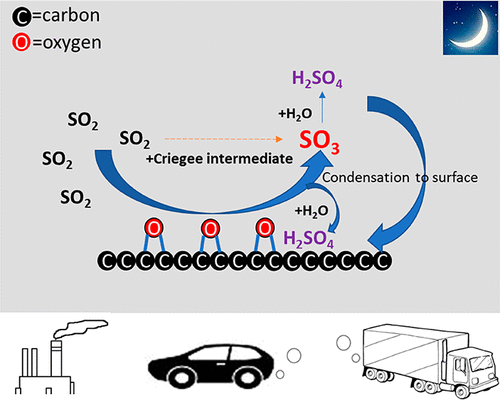当前位置:
X-MOL 学术
›
Environ. Sci. Technol. Lett.
›
论文详情
Our official English website, www.x-mol.net, welcomes your feedback! (Note: you will need to create a separate account there.)
Unprecedented Ambient Sulfur Trioxide (SO3) Detection: Possible Formation Mechanism and Atmospheric Implications
Environmental Science & Technology Letters ( IF 10.9 ) Pub Date : 2020-09-25 , DOI: 10.1021/acs.estlett.0c00615 Lei Yao 1, 2 , Xiaolong Fan 1 , Chao Yan 2 , Theo Kurtén 3 , Kaspar R. Daellenbach 2 , Chang Li 1 , Yonghong Wang 2 , Yishuo Guo 1 , Lubna Dada 2 , Matti P. Rissanen 4 , Jing Cai 2 , Yee Jun Tham 2 , Qiaozhi Zha 2 , Shaojun Zhang 5 , Wei Du 2 , Miao Yu 6 , Feixue Zheng 1 , Ying Zhou 1 , Jenni Kontkanen 2 , Tommy Chan 2 , Jiali Shen 2 , Joni T. Kujansuu 1, 2 , Juha Kangasluoma 1, 2 , Jingkun Jiang 5 , Lin Wang 7 , Douglas R. Worsnop 8 , Tuukka Petäjä 2 , Veli-Matti Kerminen 2 , Yongchun Liu 1 , Biwu Chu 2, 9, 10 , Hong He 9, 10 , Markku Kulmala 1, 2, 11 , Federico Bianchi 1, 2
Environmental Science & Technology Letters ( IF 10.9 ) Pub Date : 2020-09-25 , DOI: 10.1021/acs.estlett.0c00615 Lei Yao 1, 2 , Xiaolong Fan 1 , Chao Yan 2 , Theo Kurtén 3 , Kaspar R. Daellenbach 2 , Chang Li 1 , Yonghong Wang 2 , Yishuo Guo 1 , Lubna Dada 2 , Matti P. Rissanen 4 , Jing Cai 2 , Yee Jun Tham 2 , Qiaozhi Zha 2 , Shaojun Zhang 5 , Wei Du 2 , Miao Yu 6 , Feixue Zheng 1 , Ying Zhou 1 , Jenni Kontkanen 2 , Tommy Chan 2 , Jiali Shen 2 , Joni T. Kujansuu 1, 2 , Juha Kangasluoma 1, 2 , Jingkun Jiang 5 , Lin Wang 7 , Douglas R. Worsnop 8 , Tuukka Petäjä 2 , Veli-Matti Kerminen 2 , Yongchun Liu 1 , Biwu Chu 2, 9, 10 , Hong He 9, 10 , Markku Kulmala 1, 2, 11 , Federico Bianchi 1, 2
Affiliation

|
Sulfur trioxide (SO3) is a crucial compound for atmospheric sulfuric acid (H2SO4) formation, acid rain formation, and other atmospheric physicochemical processes. During the daytime, SO3 is mainly produced from the photo-oxidation of SO2 by OH radicals. However, the sources of SO3 during the early morning and night, when OH radicals are scarce, are not fully understood. We report results from two field measurements in urban Beijing during winter and summer 2019, using a nitrate-CI-APi-LTOF (chemical ionization-atmospheric pressure interface-long-time-of-flight) mass spectrometer to detect atmospheric SO3 and H2SO4. Our results show the level of SO3 was higher during the winter than during the summer, with high SO3 levels observed especially during the early morning (∼05:00 to ∼08:30) and night (∼18:00 to ∼05:00 the next day). On the basis of analysis of SO2, NOx, black carbon, traffic flow, and atmospheric ions, we suggest SO3 could be formed from the catalytic oxidation of SO2 on the surface of traffic-related black carbon. This previously unidentified SO3 source results in significant H2SO4 formation in the early morning and thus promotes sub-2.5 nm particle formation. These findings will help in understanding urban SO3 and formulating policies to mitigate secondary particle formation in Chinese megacities.
更新日期:2020-11-12


























 京公网安备 11010802027423号
京公网安备 11010802027423号